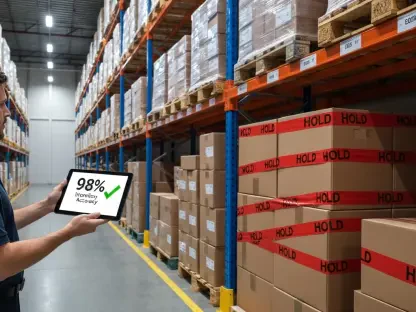The logistics industry is undergoing a significant transformation driven by the integration of automation and robotics. These advancements are not only enhancing operational efficiency but also addressing critical challenges such as labor shortages, human errors, and the need for 24/7 operations. This article explores the key trends and technologies that are revolutionizing logistics, providing a comprehensive understanding of their impact on the industry.
Evolution and Technological Revolution in Logistics
The Shift Towards Last-Mile Connectivity
The logistics industry has seen a dramatic shift towards improving last-mile connectivity. In a tech-enabled world, consumers demand faster and more efficient deliveries. This shift is driven by the need for real-time visibility and the ability to track shipments from the warehouse to the customer’s doorstep. Advanced technologies like GPS tracking, IoT devices, and mobile applications are playing a crucial role in enhancing last-mile delivery services.
With these advanced technologies, logistics companies can provide accurate and timely updates to customers about the status of their deliveries. This transparency builds customer trust and satisfaction, which is critical for maintaining a competitive edge in the market. Additionally, advancements in last-mile connectivity contribute to reducing delivery times, minimizing delays, and improving overall service performance. This transformation is essential for meeting the escalating expectations of modern consumers who seek immediacy and precision in their delivery experiences.
Enhancing Service Reach and Outputs
With the advent of automation and robotics, logistics companies can now expand their service reach and improve outputs. Automated systems and robots can handle a higher volume of tasks with greater accuracy and speed compared to human workers. This capability allows companies to scale their operations and meet the growing demands of the global market. Additionally, automation helps in reducing operational costs and improving overall efficiency.
Automated warehouses equipped with robots and AI systems can streamline processes such as sorting, packing, and shipping. These technologies not only expedite operations but also reduce the likelihood of errors that can occur with manual labor. As a result, companies can handle larger volumes of goods with fewer resources. This scalability is particularly beneficial for businesses dealing with seasonal peaks or sudden surges in demand. Moreover, the enhanced accuracy of automated systems ensures that orders are fulfilled correctly, reducing the need for returns and exchanges.
The Role of Automation in Logistics
Addressing Labor Shortages and Human Errors
One of the primary drivers of automation in logistics is the need to address labor shortages and reduce human errors. The logistics industry often faces challenges in finding and retaining skilled labor. Automation provides a solution by taking over repetitive and physically demanding tasks, allowing human workers to focus on more complex and strategic activities. This shift not only improves productivity but also enhances job satisfaction and safety for workers.
Automated systems alleviate the need for human intervention in tasks that are monotonous or hazardous, reducing the risk of injury and fatigue-related errors. For example, automated sortation systems can handle a large volume of parcels with precision, sorting them based on various criteria such as destination, size, and priority. This level of accuracy is challenging to achieve through manual sorting. Furthermore, automation helps in maintaining consistent performance standards, as machines do not experience the variability in productivity that can occur with human workers.
Ensuring 24/7 Operations and Reliability
Automation enables logistics companies to operate around the clock without interruptions. Automated systems and robots can work continuously without the need for breaks, ensuring consistent and reliable operations. This capability is particularly important in a global market where customers expect timely deliveries regardless of time zones. By leveraging automation, companies can meet these expectations and maintain a competitive edge.
The ability to operate 24/7 is a game-changer for logistics companies, as it allows them to process orders, manage inventories, and fulfill shipments at any time of day or night. This continuous operation minimizes delays and ensures that goods move through the supply chain smoothly. For businesses operating in multiple regions, the synchronization of operations across different time zones becomes seamless with automation. As a result, companies can offer faster delivery times and enhanced customer service, which are crucial for retaining customer loyalty and satisfaction.
Key Trends in Logistics Automation
The Rise of Autonomous Mobile Robots (AMRs)
Autonomous Mobile Robots (AMRs) are becoming increasingly popular in the logistics industry due to their flexibility and scalability. Unlike traditional Automated Guided Vehicles (AGVs), AMRs use advanced sensors, cameras, and machine learning algorithms to navigate dynamic environments. They are particularly useful in warehousing tasks such as order picking, inventory management, and transporting goods. AMRs can adapt to changing conditions and optimize their routes in real-time, significantly boosting operational efficiency.
AMRs offer a higher degree of autonomy and intelligence compared to their predecessors, AGVs, which typically follow fixed routes and require significant infrastructure investments. In contrast, AMRs can dynamically adjust their paths and operate in environments with human workers and other obstacles. This adaptability makes them ideal for complex warehousing operations where layout and inventory locations frequently change. Additionally, AMRs can be deployed quickly and scaled up or down based on demand, providing logistics companies with the flexibility to respond to market fluctuations.
AI and ML for Predictive Analytics
Artificial Intelligence (AI) and Machine Learning (ML) are revolutionizing logistics by enabling predictive analytics. These technologies analyze large datasets from sensors and IoT devices to predict demand fluctuations, optimize inventory levels, and recommend efficient routes. By leveraging AI and ML, logistics companies can make data-driven decisions, enhance supply chain resilience, and improve overall agility. Predictive analytics also helps in identifying potential disruptions and mitigating risks before they impact operations.
The integration of AI and ML allows logistics companies to forecast demand with greater accuracy, reducing the likelihood of stockouts or overstocking. Predictive models can analyze historical data, market trends, and external factors to anticipate future demand patterns. This foresight enables companies to plan their inventories more effectively, ensuring that the right products are available at the right time. Furthermore, AI-driven route optimization can reduce transportation costs by identifying the most efficient paths, considering variables like traffic conditions, fuel costs, and delivery time windows.
Collaborative Robots (Cobots) for Human-Robot Collaboration
Collaborative robots, or cobots, are designed to work alongside human workers, enhancing productivity while maintaining safety. Cobots assist in performing repetitive or physically demanding tasks such as sorting and packing. They are easy to deploy and reconfigure, making them ideal for dynamic logistics environments. By fostering a balance between automation and human oversight, cobots enable companies to achieve higher efficiency and flexibility in their operations.
Cobots are equipped with advanced safety features that allow them to operate in close proximity to human workers without posing a risk. For instance, they can detect human presence and adjust their speed or stop altogether to avoid collisions. This collaborative approach enhances workplace safety while also improving overall productivity. Cobots can take over tasks that would otherwise strain human workers, allowing them to focus on more complex and value-added activities. This division of labor not only increases operational efficiency but also enhances job satisfaction by reducing the physical burden on workers.
Edge Computing for Real-Time Decision Making
Reducing Latency and Bandwidth Usage
Edge computing processes data locally at or near the source, reducing latency and bandwidth usage. This capability is critical for real-time decision-making in logistics operations. By processing data closer to where it is generated, edge computing enhances the speed and accuracy of tasks such as obstacle avoidance and inventory tracking. This technology is particularly beneficial for large-scale operations that require quick responses to changing conditions.
The local processing power of edge computing reduces the need to transmit large amounts of data to centralized cloud servers, which can introduce delays and bandwidth constraints. For logistics operations, this means that critical decisions can be made instantaneously, without waiting for data to travel back and forth. For example, in automated warehouses, edge computing enables robots to quickly detect and react to obstacles, ensuring smooth and uninterrupted operations. This immediate response capability is essential for maintaining high levels of efficiency and productivity.
Enhancing Operational Efficiency
Edge computing plays a vital role in enhancing operational efficiency in logistics. By enabling real-time data processing, it allows companies to optimize their workflows and improve resource utilization. For example, edge computing can help in dynamically adjusting warehouse layouts based on current demand patterns, ensuring optimal space utilization and reducing bottlenecks. This capability leads to more efficient and responsive logistics operations.
The real-time insights provided by edge computing enable logistics managers to make informed decisions on the fly. Whether it’s reallocating resources to handle a surge in demand or adjusting delivery routes to avoid traffic congestion, edge computing provides the necessary data to act swiftly and effectively. This agility is crucial in a fast-paced industry where delays can result in significant financial losses and customer dissatisfaction. By continuously monitoring and optimizing operations, logistics companies can achieve higher levels of efficiency and maintain a competitive edge.
Sustainability Through Automation
Reducing Carbon Footprint
Sustainability is a key priority for businesses, and logistics automation plays a significant role in achieving environmental targets. Autonomous robots powered by renewable energy sources help in reducing the carbon footprint of logistics operations. Additionally, AI-driven algorithms optimize transportation routes, minimizing fuel consumption and emissions. By adopting sustainable practices, logistics companies can contribute to environmental conservation while improving their operational efficiency.
The use of renewable energy sources and energy-efficient technologies is becoming increasingly common in logistics automation. For instance, electric-powered robots and vehicles produce fewer emissions compared to their fossil-fuel counterparts. AI algorithms can analyze transportation data to determine the most fuel-efficient routes, reducing the overall carbon footprint of delivery operations. These practices not only benefit the environment but also result in cost savings for logistics companies through reduced energy and fuel expenses.
Eco-Friendly Practices and Operational Efficiency
The logistics industry is experiencing a major transformation due to the incorporation of automation and robotics. These technological advancements are significantly boosting operational efficiency while tackling pressing issues such as labor shortages, human mistakes, and the demand for constant, round-the-clock operations. The integration of these technologies allows for faster and more accurate processing, reducing the dependency on human labor and minimizing the potential for errors. Additionally, the adoption of automation and robotics enables logistics companies to operate continuously without interruptions, meeting the growing expectations for rapid and reliable service. This shift is essential to stay competitive in a market where consumers and businesses alike demand more efficient and dependable logistics solutions. This article delves into the essential trends and technologies that are reshaping the logistics landscape, offering a thorough understanding of their profound impact on the industry as a whole. By examining these developments, we can grasp how they are setting the stage for a more efficient and capable logistics sector in the future.









